
Managing Product Returns in E-commerce: Best Practices for Minimizing Returns and Maximizing Recovery
- 07 August 2023
Efficiently managing product returns is crucial for several reasons. First and foremost, it directly influences customer satisfaction and loyalty. What’s more, In a highly saturated e-commerce market, customers are spoiled for choice, and businesses that prioritize customer-centric return policies and recovery strategies stand out from the crowd.

Source: https://customerthink.com/is-your-return-policy-seamless-customer-centric/
In this text, we will explore such aspects of product returns as:
- main reasons behind product returns,
- the importance of optimizing product descriptions,
- leveraging useful technology and tools,
- the significance of product returns policies,
- planning adequate pricing strategies.
We will also see how Dealavo‘s powerful dynamic pricing and price monitoring functionalities can aid businesses in maintaining competitive prices and reducing return rates.
The Importance of Managing Product Returns in E-commerce
In the world of e-commerce, managing product returns is an essential aspect that directly impacts customer satisfaction and brand reputation.
Unlike traditional retail stores, customers in e-commerce lack the opportunity to physically inspect products before making a purchase. As a result, product returns are more prevalent in the online shopping realm. Ignoring the significance of managing returns can lead to dissatisfied customers, negative reviews, and decreased customer loyalty.
Impact on Operational Efficiency
A well-organized return process minimizes the time and resources spent on managing returns, reducing operational costs and improving overall efficiency.

Source: https://fulfillmenthubusa.com/what-is-returns-management-process/
By understanding the reasons behind returns, businesses can also identify opportunities for product improvement. Customer feedback gained from return reasons can inform product development and quality control efforts, reducing return rates over time.
Stable Growth
Managing product returns with a customer-centric approach helps retain existing customers and increase their lifetime value. A business that handles returns professionally and promptly builds trust and loyalty, fostering a loyal customer base that forms the foundation for sustainable growth.
Competing in a Saturated Market
One way businesses can differentiate themselves and stand out is by offering exceptional customer service, including an efficient return process.
Businesses that prioritize customer satisfaction and simplify the return process gain a competitive advantage, and they’re more likely to win the trust and loyalty of customers, fostering long-term relationships and repeat business.
Product Returns in E-commerce – Main Reasons
Product returns in e-commerce can occur due to various reasons, and it is crucial to understand them to devise effective strategies for minimizing returns. Below are some of the most common reasons why customers may want to return a product bought online:
- product defects – customers may return products if they receive items with manufacturing defects, damages during shipping, or functional issues;
- size and fit – clothing and footwear purchases often result in returns due to size discrepancies or unsatisfactory fit;
- misleading product descriptions – inaccurate product descriptions or misleading images can lead to customer expectations being left unsatisfied;
- change of mind – some customers return products simply because they changed their minds about the purchase, and there’s little you can do about it.
How to Manage Product Returns in E-commerce?
To handle product returns effectively, e-commerce businesses must implement specific strategies and best practices. Let’s take a look at some of them.
Implement a Clear and Transparent Return Policy
Having a clear and customer-friendly return policy is paramount in e-commerce. When customers know what to expect in case they need to return a product, they feel more confident about making a purchase.
A transparent return policy should include details on the return process, the timeframe for returns, any associated costs, and conditions for accepting returns.
Optimize Product Descriptions and Images
Ensuring that product descriptions and images are accurate and comprehensive can significantly reduce the number of returns. Make sure your customers’ expectations won’t be inadequately high regarding your products by:
- adding high-quality images,
- providing detailed product specifications,
- making other customers’ reviews easily visible.
This will help set accurate expectations and lower the chances that your customers will want to return products due to misunderstandings.
Utilize Technology to Streamline the Return Process
Leveraging technology can streamline the product return process and enhance customer experience. Implementing automated return initiation, tracking systems, and integration with shipping carriers can make the return process hassle-free for both customers and the business.
Provide Proactive Customer Support
Exceptional customer support is essential, especially when handling returns. Promptly addressing customer queries and concerns regarding returns can turn a negative experience into a positive one. Responding with empathy and understanding helps build trust and loyalty with customers.
Employ Strategies for Maximizing Recovery from Returned Products
As an e-commerce business owner, you should be aware of the ways in which you can recover value from the products returned. There are some strategies for maximizing recovery from returned products you may want to learn:
- refurbishment – it mostly concerns electronic equipment which has been refurbished and put back on the shelf once it had been returned by a customer (usually implemented in second-hand shops), but customers need to be explicitly informed about the fact that an item is not brand new;
- resale – if returned items are in pristine condition, they can be resold as “open-box,” most often through “sale” and “used” categories, offering customers discounts;
- liquidation – for products that cannot be resold, liquidation can help recover some value through bulk sales to secondary markets.

Source: https://returngo.ai/how-to-resell-returned-products/
Take Care of Your Prices
One critical aspect of managing product returns in e-commerce is the careful consideration of pricing strategies. Pricing plays a pivotal role in shaping customer purchasing decisions and directly influences the likelihood of returns.
Dealavo offers a powerful platform for dynamic pricing and price monitoring, enabling businesses to stay competitive and minimize returns. With Dealavo’s functionalities, businesses can get access to:
- reliable market data – access up-to-date market data to stay informed about pricing trends and competitor pricing strategies;
- price monitoring – monitor competitors’ prices and market changes to adjust pricing strategies proactively;
- competitive Insights – gain valuable insights into the pricing strategies of key competitors to help your business fine-tune its pricing approach.

Dealavo‘s dynamic pricing and price monitoring tools give e-commerce businesses a chance to achieve the perfect balance between profitability and customer satisfaction, reducing the likelihood of returns and fostering long-term customer loyalty.
Learn more about Dealavo!
How to Minimize Returns and Maximize Recovery in E-commerce?
Although the aspects mentioned above are equally important, e-commerce businesses can adopt additional practices to minimize returns and maximize recovery.
Leverage Customer Feedback
Actively seek feedback from customers who return products to identify patterns and recurring issues. This data can be used to improve products and reduce future returns.
Personalize Recommendations
Implement personalized product recommendations based on customer preferences and purchase history to increase customer satisfaction and reduce the likelihood of returns.
Offer Virtual Try-Ons
For clothing and accessories, offering virtual try-on options can help customers make more informed decisions, reducing returns due to size and fit issues.
This feature allows customers to digitally visualize how a product would look on them before making a purchase, providing a more accurate representation than mere product images.

Source: https://www.drip.com/blog/virtual-try-on-examples
Virtual try-ons leverage augmented reality (AR) technology, which superimposes digital images of products onto real-world environments. Customers can see themselves in the product through their device’s camera or by uploading a photo.
Incentivize Retention
Offer loyalty rewards, discounts, or free return shipping for repeat customers to encourage customer retention and loyalty.
Here are some powerful ways to incentivize retention in e-commerce:
- loyalty programs – customers accumulate points which they can redeem for discounts or special offers, motivating them to keep coming back;
- personalized offers – personalized offers make customers feel valued and understood, increasing their loyalty to the brand;
- birthday rewards – birthday rewards create a sense of personal connection and appreciation;
- gamification – earning badges or completing challenges can make the shopping journey more fun and engaging.
Conclusion
By implementing transparent return policies, optimizing product descriptions, leveraging technology, providing exceptional customer support, and adopting dynamic pricing strategies with Dealavo’s functionalities, businesses can minimize returns and create a positive shopping experience for customers.
Additionally, employing recovery strategies like refurbishment, resale, and liquidation can help recover value from returned products.
Managing product returns effectively may greatly impact your overall e-commerce growth and increase sales in the longer run as well.




